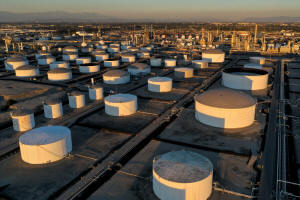|
Brent crude futures rose 76 cents, or 0.9%, to $81.44 per barrel
by 1144 GMT, while U.S. West Texas Intermediate (WTI) crude
futures were up 80 cents at $76.19.
The Brent contract is firmly back in a backwardated market
structure whereby front-month loading barrels trade higher than
later deliveries, which indicates worries about oversupply are
subsiding.
The structure had dipped into contango last week, with
front-month deliveries cheaper than later-loading ones.
Looking into 2023, OPEC said it expects oil demand to grow by
2.25 million barrels per day (bpd) over next year to 101.8
million bpd, with potential upside from China, the world's top
importer.
The IEA, seeing Chinese oil demand recovering next year after a
400,000 bpd contraction in 2022, raised its 2023 oil demand
growth estimate to 1.7 million bpd for a total of 101.6 million
bpd.
Road and air traffic in China has rebounded sharply, data
suggests.
But PVM analyst Stephen Brennock cautioned that while "Beijing’s
recent decision to loosen the strict COVID-19 policies is a
positive step (it) is only expected to pave the way for an
uptick in China’s oil demand from 2Q23 onwards."
The U.S. consumer price index rose 0.1% in November after a 0.4%
rise the previous month, fuelling hopes for a slowdown in
interest rate hikes, which in turn could support oil prices.
U.S. Federal Reserve policymakers are expected to raise rates by
50 basis points later on Wednesday, slowing from the
75-basis-point pace they had stuck to since June.
Oil prices have been supported by a leak and outage of TC Energy
Corp's Keystone Pipeline, which ships 620,000 barrels per day of
Canadian crude to the United States.
Officials said the cleanup will take at least several weeks.
Sending bearish signals, U.S. crude inventories rose 7.8 million
barrels in the week to Dec. 9, according to sources citing data
from the American Petroleum Institute, while analysts polled by
Reuters expected a 3.6 million barrel drop. [API/S]
U.S. crude stockpile data is due from the Energy Information
Administration (EIA), the statistical arm of the Department of
Energy, at 1530 GMT. [EIA/S]
(Additional reporting by Sonali Paul in Melbourne and Emily Chow
in Singapore; editing by Jason Neely)
[© 2022 Thomson Reuters. All rights
reserved.]
This material may not be published,
broadcast, rewritten or redistributed.
Thompson Reuters is solely responsible for this content.

|
|





